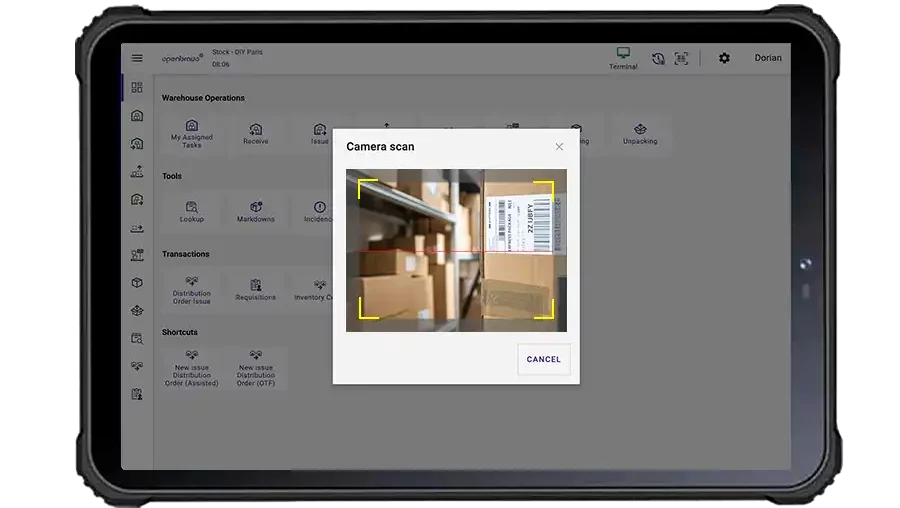Unified commerce: tools and methods to simplify inventory management across all channels

In today’s market, consumers expect a smooth and consistent experience throughout their shopping journey. Unified commerce offers an optimal solution by centralizing data and ensuring real-time inventory management across all channels. Be it in-store, online sales sites, or warehouses, unified commerce provides efficient inventory management.
This article explores the challenges and benefits of a centralized approach, especially in terms of inventory management and customer experience. Learn how centralized inventory management can significantly enhance your business performance.
Interested in our solutions?
Understanding unified commerce
Definition of unified commerce
Unified commerce is an integrated strategy that connects all channels of a brand through a centralized system. It uses a single database to ensure continuity across all touchpoints. This approach not only enhances the customer experience but also streamlines internal operations, beginning with inventory management.
Unified inventory management simplifies and enhances efficiency by centralizing all stock information in real-time, regardless of the data’s origin (warehouses, physical stores, or online channels.)
Gain full control and visibility of your inventory with our solutions. Explore our solutions.
The challenges of multichannel commerce
Managing multiple channels independently, known as multichannel commerce, presents several challenges:
- Inventory management becomes complex without a centralized view, making it difficult to monitor product locations in real-time and leading to inefficient management. This issue directly affects customer satisfaction, particularly when a product is indicated as available but isn’t.
- The lack of unity disrupts the experience: a customer transitioning from online to in-store expects consistency, such as accurate stock, and options to reserve, exchange, or return products at any touchpoint.
- Large networks face amplified challenges: more channels and sites lead to increased inventory management costs and synchronization difficulties.
The importance of channel integration
Integrating channels transforms separate operations into a cohesive system where teams and systems work together seamlessly. For inventory management, this integration means centralizing data from all channels to provide a comprehensive view of stock levels.
For customers, channel integration guarantees a consistent experience. For instance, a consumer can check store stock online, order the product, and pick it up in-store or return an online purchase directly in-store.
Are fragmented inventory management practices costing you sales? Experience the benefits of unified inventory management with our solutions.
Simplifying inventory management
The challenges of multichannel inventory management
Managing inventory across multiple channels without integrated software is akin to juggling disjointed and hard-to-utilize data. Visibility is one of the prime challenges businesses face. Without a clear view of available products, the risk of overstock and stockouts increases, damaging consumer relationships. Reliable synchronization methods also prevent duplicate orders.
Team coordination becomes challenging; information flows poorly, methods differ across channels, and inventory management becomes time-consuming, reducing daily efficiency.
Another issue is rigid stock allocation. When one channel is out of stock while another holds inventory, the absence of stock sharing hinders optimal management. Additionally, cross-channel product returns complicate inventory management. Without a centralized system, tracking stock movements and ensuring smooth product handling is difficult, leading to logistical costs due to errors in returns or shipments.
Transform your inventory management with Orisha Commerce! Reduce costs, enhance accuracy, and offer an optimal experience.
How unified commerce optimizes inventory visibility
Unified commerce employs a robust data centralization method, providing companies with comprehensive visibility of their entire inventory, regardless of location.
Consider a company with physical stores, an online sales site, and a warehouse. Using a centralized approach, stock levels automatically synchronize across all channels. When a product is sold online or in-store, the inventory updates instantly throughout the system, adjusting the available quantity.
This approach also allows companies to reallocate inventory smartly. If one store has surplus stock, the system can suggest transferring it to another store where demand is higher.
By analyzing sales histories, companies can predict the optimal quantity to order, reducing costs from inventory management errors.
Optimize your processes and streamline inventory management with Orisha Commerce solutions. Our inventory management software boosts agility through real-time visibility.
Tools and technologies facilitating inventory management
Effective management relies on robust inventory management software capable of centralizing data across channels. ERP systems and OMS are pivotal in this centralization, particularly in managing stock levels, and offer comprehensive activity tracking. When integrated across all channels, they prevent information gaps and ensure seamless operations.
WMS systems play a critical role in accurately tracking each quantity received into stock or shipped. They optimize warehouse operations and deliver real-time inventory visibility. Concurrently, modern POS software connected to a centralized platform enables companies to report physical sales in real time.
The integration method of management tools is essential for achieving fluid communication. Unified commerce platforms consolidate all these tools within a single interface, ensuring uninterrupted information flow. They streamline restocking planning and enhance supply chain efficiency, making inventory management more fluid. Openbravo SSMS exemplifies this, offering intuitive, automated, and centralized software designed to simplify multichannel inventory management. It enables you to view all your stock on one platform, optimize your replenishments, and minimize the risk of stockouts.

Would you consider refreshing your inventory management approach to boost efficiency? By adopting Openbravo SSMS, companies save valuable hours weekly—less time spent synchronizing inventories, correcting errors, or coordinating logistics teams. They achieve greater agility and can focus on what truly matters. Envision stress-free, fluid, and controlled inventory management, where every order is directed to the appropriate storage location, and your teams have accurate information promptly.
Worried about the complexities of a system change? Don’t be! Openbravo SSMS integrates easily with your existing setup, thanks to its built-in connectors and dedicated support. You will never be alone in this transition. Discover our inventory management software today!

Enhancing the experience through unified commerce
The impact of unified inventory management on the shopping journey
Unified commerce significantly transforms the shopping journey by eliminating barriers between channels. Instead of customers having to adapt to a brand’s technical limitations, companies now adapt to consumer habits, providing continuous service across all touchpoints.
From the moment of product search, customers can check inventory availability both online and in nearby stores. They expect accurate information on product quantities. Purchase options include in-store pickup, home delivery, or shipment from another store. After placing orders, customers can track shipments, return online purchases in-store, or exchange products at different points of sale.
How to meet consumer expectations
Consumers today desire smooth and personalized experiences, expecting every interaction with a brand to be simple and friction-free. Furthermore, 69% of French consumers think that an integrated multichannel experience is crucial.
A coherent experience stems from flawless channel continuity, allowing consumers to begin their journey on a website, continue it in-store, and complete their purchase via a mobile app without any friction.
Consumers also demand personalized journeys, with 85% seeking an enhanced experience. Utilizing data can help companies offer advanced personalization. Moreover, consumers want to choose where, when, and how they shop—with 64% showing increased interest in brands that provide an omnichannel experience.
Centralize your inventory management with our software solutions!
Benefits for customer loyalty
Customer data analysis enables the creation of tailored offers for each client. Unified commerce enhances personalization on a large scale by consolidating information from all channels. This strategy makes it possible to implement various hybrid scenarios, such as picking up a product in-store after purchasing it online.
Centralized management of customer data, inventory, and products reduces human error and provides customers with the ability to track orders in real-time, check product availability, and experience a transparent returns process.
How do you optimize your customer experience? Achieve a centralized view of your inventory and boost satisfaction with our inventory management solutions!
Strategies for successful implementation
Key steps for optimized inventory
To move to centralized inventory management, companies need to assess their existing systems. This involves understanding how different tools interact to pinpoint areas of friction. Next, choosing an appropriate platform is essential. It should centralize customer, product, and inventory information from all channels while seamlessly integrating with existing systems. Training teams in this approach to inventory management ensures smooth adoption. Consistently monitoring performance is crucial for fine-tuning the strategy.
Synchronize all your data for a centralized view with our unified inventory management solutions!
Necessary partners and resources
Software providers are pivotal to the success of such projects. Partnering with these technical and functional experts offers companies the necessary support for smooth and optimal solution implementation. Utilize unique expertise and best practices!
Furthermore, predictive analytics and artificial intelligence tools enable companies to make the most of centralized data. These technologies analyze customer behaviors and precisely anticipate needs, providing valuable insights for personalization and optimizing inventory management.
Measuring efficiency and adjusting the strategy
Monitor key performance indicators such as:
- Inventory availability rate (influencing demand fulfillment capability);
- Inventory turnover rate;
- Demand forecast accuracy;
- Replenishment lead times;
- Inventory management costs.
These indicators help companies assess the effectiveness of their inventory management strategy, ensuring products are available on time and costs are controlled.
Business intelligence software simplifies this measurement. These tools allow companies to continuously optimize inventory management processes, enhancing responsiveness to market fluctuations. Moreover, centralized inventory management aligns stock levels with production.
Discover how Openbravo Reporting can enhance your efficiency! Access reliable data for informed decision-making with our statistical analysis platform.
Unified commerce is the key for companies aiming to meet the increasing expectations of consumers. By centralizing data, it ensures smooth inventory management across all channels. Adopting unified inventory management solutions enables businesses to tackle today’s retail challenges with agility and efficiency.
Don’t let fragmented inventory management hold back your growth! Choose centralized management and provide your customers with a seamless experience. Learn how Orisha Commerce can transform your inventory management and enhance customer satisfaction. Request a demo of our solution today!
Frequently asked questions
What is the impact of multichannel sales on inventory management?
Multichannel sales complicate inventory management due to varied channels, leading to inconsistencies in product availability, stockouts, or overstock. Centralizing data (clients, inventory, and products) resolves these issues by providing a real-time view across all channels.
What are the benefits of unified commerce for businesses?
Unified commerce enables businesses to centralize operations, improving inventory management, coordination between sales channels, and the customer experience. It offers enhanced real-time inventory visibility and more agile management of product orders and returns.
How to evaluate the effectiveness of inventory management?
Effectiveness in inventory management can be assessed using key performance indicators like inventory turnover rate, service level, and storage costs. Monitoring these KPIs helps identify improvement areas and adjust inventory management strategies accordingly.
What is the best method to optimize inventory management?
There is no single method. Optimization relies on regular performance analysis, data centralization, and adopting an agile approach to adjusting inventory levels based on actual demand.




